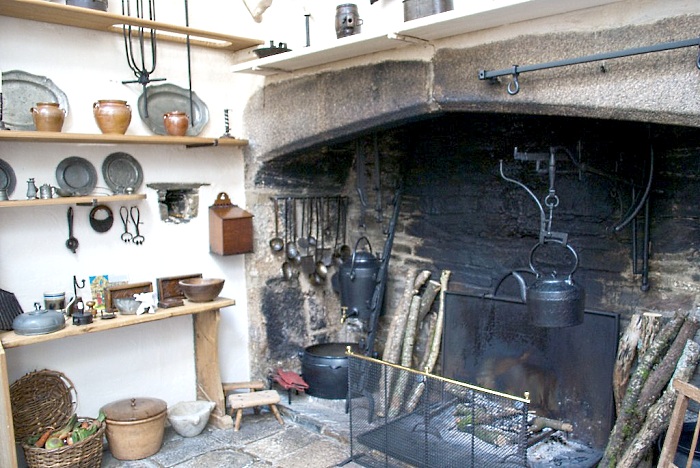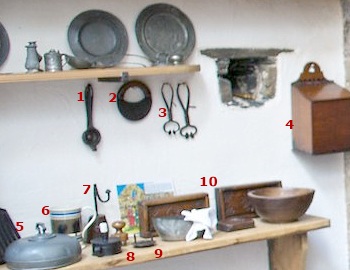
Whenever I travel I look out for historic houses, especially if they have kitchens worth visiting, and enjoy picking out bits and pieces for a closer look.
And yet the room often isn’t the way it would have looked at any time in its life. The picture above is of a 16th century English manor house kitchen, amazingly unchanged in its basic structure. The Tudor open hearth with old iron pots and logs in a smoke-blackened fireplace is wonderful, but when did that protective fireguard appear? The things on the shelves come from various different periods in the life of the house. When and where did each pot, plate, or tool start its useful life? Does knowing matter? For myself, I enjoy seeing a kaleidoscope of things that have belonged to the house over the generations – but it’s still good to know what’s what.*
What can you identify in the picture?
Ironware
In the fireplace the classic iron kettle hanging on a chimney crane is centuries-old way of heating water. The crane may have arrived in the kitchen in the 17th or 18th century to replace a simpler kind of hanger. There’s also an “idleback” kettle tilter to help with pouring, probably not there originally. The urn to the left has a brass tap that may be relatively modern. The assorted spoons, ladles, and skimmers look timeless; you’d have to examine them hands-on to try guessing their dates. A trivet sits under the red cloth. Out of sight above the mantel-shelf are racks for roasting spits, and a cradle-spit for roasting small birds or joints of meat is hanging down into the upper left of the picture. Many big kitchens acquired fancier mechanised roasting equipment and cooking ranges or stoves well before 1900, but I understand this room was in use, unmodernised, until 1946. (There’s an old oven in one of the walls you can’t see.)

Smaller iron things on the shelves and nearby include two pairs of sugar cutters (3), a rushlight holder (7), lemon squeezer (1), and vegetable cutter (2) – suitable for hacking up root vegetables and big cabbages.
Woodware
A wooden salt box (4) hanging to the left of the fireplace has a traditional sloping lid and carved hanging loop. On the shelf below is a nice turned bowl. The two flat moulds with decorative carving (10) have left me wondering. Are they unusually long, flat butter moulds, or an uncommon kind of gingerbread mould with sides, or something else?
Biscuit pricker
The small wooden stamp with a round handle (8) is a biscuit pricker. With lots of little needles on the base, it was used before baking to perforate the dough for thin crackers, to help them stay flat in the oven. Think of it when you see the holes in British water biscuits or American graham crackers. The metal stamp (9) is probably a cookie cutter or biscuit docker: for cutting out small baked goods and possibly adding a pattern.
Water Biscuits: Into one pound of flour rub three ounces of butter, add a sufficient quantity of water to make it a stiff dough; well knead it, and roll it as thin as wafers; prick with a biscuit-pricker, and bake a very pale brown. (1870s UK recipe)
Other things
On the shelves are pewter plates and a metal cloche or dish-cover (5) that looks factory-made. The earthenware mug (6) is mocha ware, almost certainly for beer. This design with coloured bands and black-brown “trees” first appeared in the very late 18th century and was often seen in 19th century pubs where it might be government-certified as a pint or half-pint measure. Similar earthenware mugs were also used for the servants’ ale in big houses.†
On the floor, next to the big unglazed ceramic storage pot with lid, is a stone mortar without its pestle. It has those familiar triangular bits round the upper edge, but what are they for? The hole in the wall is the kind that might be used as a candle and rushlight store: handily near the fire for lighting.
More
If you like to ID old kitchen items, try the things in a 1920s ranch kitchen or a German kitchen around 1930.
Notes
*Please note these are general remarks about all sorts of places, and are not in any way a criticism.
†See Pamela Sambrook’s Country House Brewing in England.
You may be interested in this list of links to sites that help you research kitchen antiques and historic culinary utensils.
Also see this piece about where a butter worker belongs. Was it always in the kitchen?
Photos
Photographers credited in captions. This is the original kitchen photo, or see more picture info here.
You missed the most importany item! The tinderbox just behind item 8. Without this, no fire!
Good post, more of it. Thank you.
Regards, Keith.
A Woodsrunner’s Diary blog.
LikeLike
I’ve been thinking about tinderboxes in historic houses. You don’t see them often when you look round old kitchens, unless I’m just not noticing. Anyway, you inspired me to write about domestic tinderboxes here:
http://www.oldandinteresting.com/tinderbox.aspx
LikeLike
Thanks, Keith. Great that you came along and spotted that. For anyone reading along, the tinderbox is the thing that looks like a candle holder on a small box.
I see from your blog you are an expert on making fire and other interesting things – I’m off to read more.
Thanks again for pointing out the “most important” thing! Lel
LikeLike
I do believe those triangular bits around the edge of the mortar, are handles?
LikeLike
Joanne, thanks. I think you must be right, but I keep having a discussion with myself about this! Are they handles to help you steady it while you’re pounding stuff? If so, they don’t seem like a very good shape to suit a human hand. Are they to help when lifting the mortar? I guess maybe they’re the best handles you can carve out of a lump of stone while you’re making a bowl.
Obviously I spend way too much time thinking about stuff like that. Maybe if I went off to spend a day actually using one of those things I would understand it better. Please do say if you have any more thoughts on this.
Lel
LikeLike
Actually, I could use some handles like that on the mortar and pestle I use at work. You don’t want a ‘holed’ handle like a mug would have, your hand would get caught and make life even more fidgety when trying to pulverize ingredients. But nobs like those on this particular model are wonderful since you can cup them with your hands and brace against them for extra force. There’s enough room to add a thumb to the top of the nob to get even more leverage.
LikeLike
This makes it even more difficult to access electrical outlets
easily. Place bowls of charcoal briquettes inside musty cabinets and drawers, and allow them to remain undisturbed for at least 24 hours.
For example, providing a lazy couch in the break room compels the employees to sit back
and take a break for a while.
LikeLike
Woah! I’m really enjoying the template/theme of this blog.
It’s simple, yet effective. A lot of times it’s very hard to
get that “perfect balance” between superb usability and visual appeal.
I must say you’ve done a awesome job with this. In addition, the blog loads extremely
quick for me on Firefox. Outstanding Blog!
LikeLike
Lauri, I hope you pressed enter before you meant to because you have several spelling and grammar issues yourself.
LikeLike
Touche. Solid arguments. Keep up the amazing effort.
LikeLike
You can definitely see your enthusiasm in the work you write.
The sector hopes for even more passionate writers like you who aren’t afraid
to say how they believe. At all times follow your heart.
LikeLike